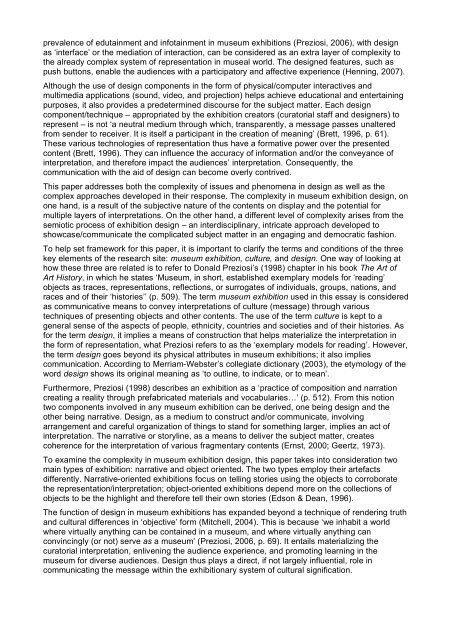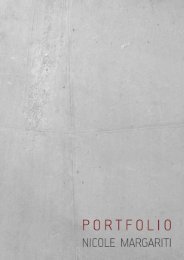Complexity_in_Museum_Exhibition_Design
Create successful ePaper yourself
Turn your PDF publications into a flip-book with our unique Google optimized e-Paper software.
prevalence of eduta<strong>in</strong>ment and <strong>in</strong>fota<strong>in</strong>ment <strong>in</strong> museum exhibitions (Preziosi, 2006), with design<br />
as ‘<strong>in</strong>terface’ or the mediation of <strong>in</strong>teraction, can be considered as an extra layer of complexity to<br />
the already complex system of representation <strong>in</strong> museal world. The designed features, such as<br />
push buttons, enable the audiences with a participatory and affective experience (Henn<strong>in</strong>g, 2007).<br />
Although the use of design components <strong>in</strong> the form of physical/computer <strong>in</strong>teractives and<br />
multimedia applications (sound, video, and projection) helps achieve educational and enterta<strong>in</strong><strong>in</strong>g<br />
purposes, it also provides a predeterm<strong>in</strong>ed discourse for the subject matter. Each design<br />
component/technique – appropriated by the exhibition creators (curatorial staff and designers) to<br />
represent – is not ‘a neutral medium through which, transparently, a message passes unaltered<br />
from sender to receiver. It is itself a participant <strong>in</strong> the creation of mean<strong>in</strong>g’ (Brett, 1996, p. 61).<br />
These various technologies of representation thus have a formative power over the presented<br />
content (Brett, 1996). They can <strong>in</strong>fluence the accuracy of <strong>in</strong>formation and/or the conveyance of<br />
<strong>in</strong>terpretation, and therefore impact the audiences’ <strong>in</strong>terpretation. Consequently, the<br />
communication with the aid of design can become overly contrived.<br />
This paper addresses both the complexity of issues and phenomena <strong>in</strong> design as well as the<br />
complex approaches developed <strong>in</strong> their response. The complexity <strong>in</strong> museum exhibition design, on<br />
one hand, is a result of the subjective nature of the contents on display and the potential for<br />
multiple layers of <strong>in</strong>terpretations. On the other hand, a different level of complexity arises from the<br />
semiotic process of exhibition design – an <strong>in</strong>terdiscipl<strong>in</strong>ary, <strong>in</strong>tricate approach developed to<br />
showcase/communicate the complicated subject matter <strong>in</strong> an engag<strong>in</strong>g and democratic fashion.<br />
To help set framework for this paper, it is important to clarify the terms and conditions of the three<br />
key elements of the research site: museum exhibition, culture, and design. One way of look<strong>in</strong>g at<br />
how these three are related is to refer to Donald Preziosi’s (1998) chapter <strong>in</strong> his book The Art of<br />
Art History, <strong>in</strong> which he states ‘<strong>Museum</strong>, <strong>in</strong> short, established exemplary models for ‘read<strong>in</strong>g’<br />
objects as traces, representations, reflections, or surrogates of <strong>in</strong>dividuals, groups, nations, and<br />
races and of their ‘histories’’ (p. 509). The term museum exhibition used <strong>in</strong> this essay is considered<br />
as communicative means to convey <strong>in</strong>terpretations of culture (message) through various<br />
techniques of present<strong>in</strong>g objects and other contents. The use of the term culture is kept to a<br />
general sense of the aspects of people, ethnicity, countries and societies and of their histories. As<br />
for the term design, it implies a means of construction that helps materialize the <strong>in</strong>terpretation <strong>in</strong><br />
the form of representation, what Preziosi refers to as the ‘exemplary models for read<strong>in</strong>g’. However,<br />
the term design goes beyond its physical attributes <strong>in</strong> museum exhibitions; it also implies<br />
communication. Accord<strong>in</strong>g to Merriam-Webster’s collegiate dictionary (2003), the etymology of the<br />
word design shows its orig<strong>in</strong>al mean<strong>in</strong>g as ‘to outl<strong>in</strong>e, to <strong>in</strong>dicate, or to mean’.<br />
Furthermore, Preziosi (1998) describes an exhibition as a ‘practice of composition and narration<br />
creat<strong>in</strong>g a reality through prefabricated materials and vocabularies…’ (p. 512). From this notion<br />
two components <strong>in</strong>volved <strong>in</strong> any museum exhibition can be derived, one be<strong>in</strong>g design and the<br />
other be<strong>in</strong>g narrative. <strong>Design</strong>, as a medium to construct and/or communicate, <strong>in</strong>volv<strong>in</strong>g<br />
arrangement and careful organization of th<strong>in</strong>gs to stand for someth<strong>in</strong>g larger, implies an act of<br />
<strong>in</strong>terpretation. The narrative or storyl<strong>in</strong>e, as a means to deliver the subject matter, creates<br />
coherence for the <strong>in</strong>terpretation of various fragmentary contents (Ernst, 2000; Geertz, 1973).<br />
To exam<strong>in</strong>e the complexity <strong>in</strong> museum exhibition design, this paper takes <strong>in</strong>to consideration two<br />
ma<strong>in</strong> types of exhibition: narrative and object oriented. The two types employ their artefacts<br />
differently. Narrative-oriented exhibitions focus on tell<strong>in</strong>g stories us<strong>in</strong>g the objects to corroborate<br />
the representation/<strong>in</strong>terpretation; object-oriented exhibitions depend more on the collections of<br />
objects to be the highlight and therefore tell their own stories (Edson & Dean, 1996).<br />
The function of design <strong>in</strong> museum exhibitions has expanded beyond a technique of render<strong>in</strong>g truth<br />
and cultural differences <strong>in</strong> ‘objective’ form (Mitchell, 2004). This is because ‘we <strong>in</strong>habit a world<br />
where virtually anyth<strong>in</strong>g can be conta<strong>in</strong>ed <strong>in</strong> a museum, and where virtually anyth<strong>in</strong>g can<br />
conv<strong>in</strong>c<strong>in</strong>gly (or not) serve as a museum’ (Preziosi, 2006, p. 69). It entails materializ<strong>in</strong>g the<br />
curatorial <strong>in</strong>terpretation, enliven<strong>in</strong>g the audience experience, and promot<strong>in</strong>g learn<strong>in</strong>g <strong>in</strong> the<br />
museum for diverse audiences. <strong>Design</strong> thus plays a direct, if not largely <strong>in</strong>fluential, role <strong>in</strong><br />
communicat<strong>in</strong>g the message with<strong>in</strong> the exhibitionary system of cultural signification.




